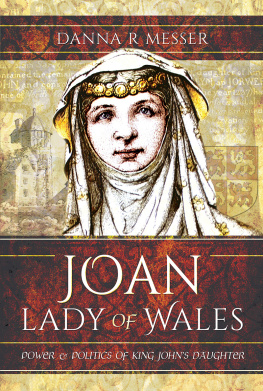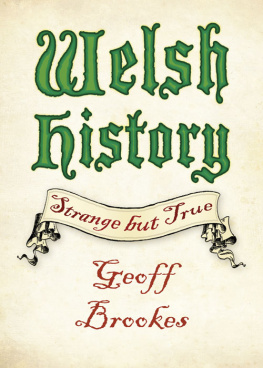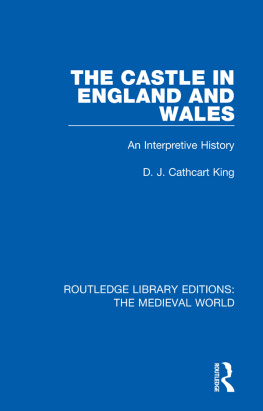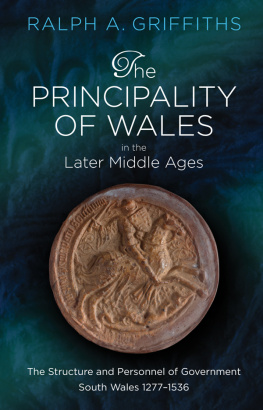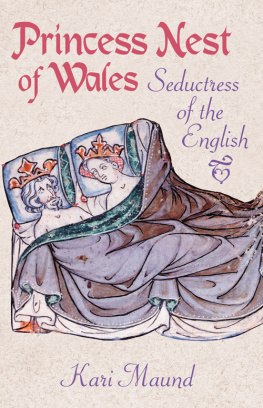Pagebreaks of the print version

JOAN, LADY OF WALES
POWER AND POLITICS OF KING JOHNS DAUGHTER
Patri meo
(19452018)
Si itaque in aliquo mihi credere velitis,
in hoc mihi fidem adhibere velitis. Valete.
Therefore if you wish to have confidence in me for anything else, put your faith in me for this. Farewell.
Joan, Lady of Wales
I Siwan
It will be seen that there are still problems which call for solutions in the history of this shadowy figure, but I trust that I have done something to clear the foundations for future building.
John Edward Lloyd
JOAN, LADY OF WALES
POWER AND POLITICS OF KING JOHNS DAUGHTER
Danna R Messer
First published in Great Britain in 2020 by
PEN AND SWORD HISTORY
An imprint of
Pen & Sword Books Ltd
Yorkshire Philadelphia
Copyright Danna R Messer, 2020
ISBN 978 1 52672 929 3
eISBN 978 1 52672 930 9
Mobi ISBN 978 1 52672 931 6
The right of Danna R Messer to be identified as Author of this work has been asserted by her in accordance with the Copyright, Designs and Patents Act 1988.
A CIP catalogue record for this book is available from the British Library.
All rights reserved. No part of this book may be reproduced or transmitted in any form or by any means, electronic or mechanical including photocopying, recording or by any information storage and retrieval system, without permission from the Publisher in writing.
Pen & Sword Books Limited incorporates the imprints of Atlas, Archaeology, Aviation, Discovery, Family History, Fiction, History, Maritime, Military, Military Classics, Politics, Select, Transport, True Crime, Air World, Frontline Publishing, Leo Cooper, Remember When, Seaforth Publishing, The Praetorian Press, Wharncliffe Local History, Wharncliffe Transport, Wharncliffe True Crime and White Owl.
For a complete list of Pen & Sword titles please contact
PEN & SWORD BOOKS LIMITED
47 Church Street, Barnsley, South Yorkshire, S70 2AS, England
E-mail:
Website: www.pen-and-sword.co.uk
Or
PEN AND SWORD BOOKS
1950 Lawrence Rd, Havertown, PA 19083, USA
E-mail:
Website: www.penandswordbooks.com
Acknowledgments
This has been a journey that has lasted more than twenty years with many more years surely to come. Though Joans life seems to be poorly recorded, there are numerous avenues that have been taken to get to this point; and numerous avenues still yet to take. As such, perhaps its most suitable to acknowledge in the Acknowledgments the fact that much contexualisation appears within the following pages. The old adage that the invisibility in sources doesnt naturally preclude invisibility in life couldnt be more apropos for this woman, or the events that took place in the early thirteenth century between Wales and England. Although various suppositions appear as to Joans involvement in various instances and her appearances at various events, they are based on evidence that often points to probability or possibility. Ultimately, the goal is to offer additional layers of discussion concerning the history of native Wales and womens involvement as members of society, particularly in the realms of politics. It is a discussion that is long overdue. Of course, any errors are solely of my own doing.
The support I have received from family, friends and colleagues over the years has been unwavering and its difficult to know where to even begin the humble process of saying thank you. As such, this is kept short and sweet. I want to thank Huw Pryce and Louise Wilkinson for all the guidance and encouragement theyve given me, as a long-ago PhD student and as a colleague. Their swift responses to last minute cries for help should especially be recognised. I would also like to thank John Northall for his kind permission to let me use his photographs of Garth Celyn. To my editors Claire Hopkins, for providing me with life-changing opportunities, enthusiasm for all things medieval and a wonderful friendship, and Karyn Burnham whose careful edit and patience deserve more than a few gold stars, an enormous thank you. I also want to give a very warm thank you to Laura Hirst, Production Coordinator, for her incredible efficiency and for being so wonderful to work with, both as an author and editor.
Most importantly, my heartfelt thanks goes to my stalwart posse of amazing women, some of whom have been in my life for over forty years (you know who you are). You deserve the biggest and most important thanks of all: Athea Merredyth, Linda R. Messer, Jane Anderson, Lucy Chandler, Hannah Clifford, Leslie Hebb, Jen Kochenash, Kelly Langford, Barbara Reyman and Laura Salisbury. You are all Wonder Women. That is all that needs to be said.
Last, but most certainly not least, to Imp for keeping me entertained and for bringing me all the gifts and tokens of love every time the going seemed to get rough. Though, I would prefer flowers rather than baby rodents and avian dinosaurs.
Introduction
It was with great lament that on Monday, 2 February 1237 (Candlemass), the body of the long-reigning consort of the titular prince of Wales was transported from the royal residence of Aber on the north Walian mainland, across the Menai Straits to the ancient holy isle of Anglesey. There on the eastern shores, in the royal demesne of Llanfaes, Joan, Lady of Wales, was buried to views across the dark Irish Sea and formidable Eryri mountains, rearing their lofty summits up to the clouds. In grief over his tremendous loss, her husband, the renowned Llywelyn ap Iorwerth (r. 11951240) established the Franciscan house of Barefooted Friars to be built in honour of the soul of his beloved wife. Thereafter, the monastery erected around Joans final resting place became the royal mausoleum for the successive royal consorts of the princes of Gwynedd.
The death of Joan of England, Siwan to the Welsh, was not just of enormous personal loss for her husband of over thirty years, and their grown children. The king of England was also dealt a great personal blow. The Lady of Wales was his sister and one he was seemingly close to. The impact of her death was also felt politically. Arguably, that sorrowful February Monday is the moment that Anglo-Welsh relations began to tilt slowly on its axis towards an inevitable and permanent decline. Unarguably, her death marked a shift in relations. Without Joans experience as a diplomat to fall back on, and her position in both the Welsh and English courts as a beloved wife, daugther and sister, the first tremors of change rumbled. Many more powerful tremors followed over the next forty-five years eventually leading to the catastrophic political earthquake of 1282 and the permanent conquest of Wales by Englands Edward I (r. 12721307).
This is the story of Joan of England, illegitimate daughter of King John (r. 11991216) and wife of Llywelyn the Great of Wales. Over the course of a life that spanned close to fifty years, Joans own power and repute rose to great heights from very humble beginnings. Much lauded for her role in the history of medieval Wales, she was a woman who successfully influenced a generation of Anglo-Welsh politics. Joan fulfilled the traditional expectations of a woman of her royal status, acting as a peace-weaver and merciful conduit between two powerful families. As with many royal woman of the Middle Ages, the situation she found herself in melded the personal and the political. Hers, therefore, is a story that is invariably intertwined with very real personal and political relationships from relationships that aided in the elevation of her status and that of her own familys on a wider political scale, to one in particular that threatened to destabilise her husbands authority and disrupt the precarious peace between a fragmented Wales and her mighty English neighbour.

